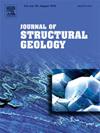3D variation of shortened salt walls from the Moroccan Atlas: Influence of salt inclusions and suprasalt sedimentary wedges
Abstract
We present a field study of salt ridges and minibasins of the Moroccan High Atlas near Rich that shows the along- and across-strike variability of such structures. Salt walls evolved from halokinesis during Jurassic rifting, to shortening during Cenozoic orogeny. Salt wall segments exhibit variable degrees of welding due primarily to the local presence of intrasalt inclusions (basalt and gabbro) rather than orientation with respect to the shortening or position along the ridge. Flanking Jurassic minibasins may be upright and symmetric or tilted; tilting may have started during halokinesis but was largely acquired during shortening. Minibasins tilt away from welded diapiric segments towards inclusion-rich segments, indicating differential diapir rise. The structure of the central parts of the salt walls differs from the lateral terminations. While the central parts are relatively simple with aperture or welding governed by the inclusions, many salt walls end buried by suprasalt sedimentary wedges. These perched wedges were not arched upward during diapir squeezing but were unexpectedly folded into synclines. The folding was formed by the flanking minibasin tilting in one limb and by inhomogeneous diapir rise and lateral salt escape in the other, thus defining a new modality of roof and shoulder folding above salt diapirs.

 求助内容:
求助内容: 应助结果提醒方式:
应助结果提醒方式:


